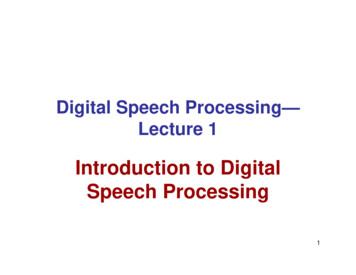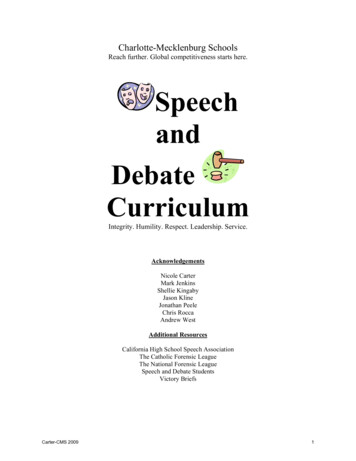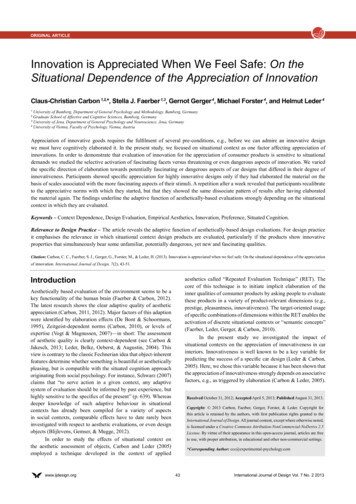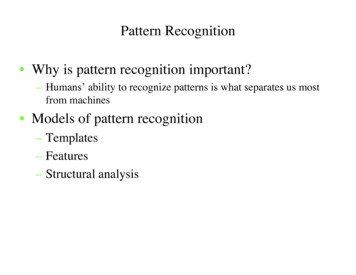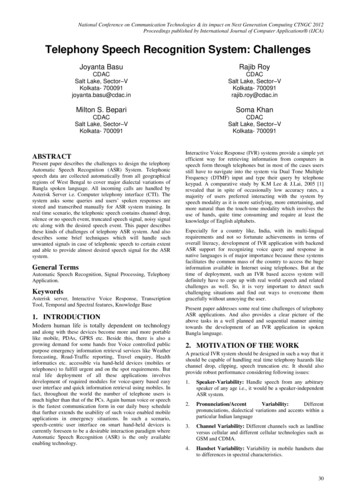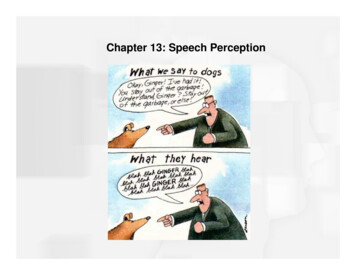
Transcription
Chapter 13: Speech Perception
Overview of Questions Can computers perceive speech as well as humans?Why does an unfamiliar foreign language often sound like a continuousstream of sound, with no breaks between words?Does each word that we hear have a unique pattern of air pressurechanges associated with it?Are there specific areas in the brain that are responsible for perceivingspeech?
Can computers perceive speech as well as humans?
The Speech Stimulus Phoneme - smallest unit of speech that changes meaning in a word– In English there are 47 phonemes: 13 major vowel sounds 24 major consonant sounds– Number of phonemes in other languages varied—11 in Hawaiianand 60 in some African dialects
The Acoustic Signal Produced by air that is pushed up from the lungs through thevocal cords and into the vocal tract Vowels are produced by vibration of the vocal cords andchanges in the shape of the vocal tract
The Sound Spectrogram‘frequency sweep’3000Frequency .80.9
The Sound Spectrogrammy (lame) attempt at a ‘frequency sweep’3000Resonant frequencies, or ‘formants’Frequency (Hz)250020001500100050000.20.40.6Time0.81
Vowel sounds are caused by a resonant frequency of the vocal cords and producepeaks in pressure at a number of frequencies called formantsThe first formant has the lowest frequency, the second has the next highest, etc.‘ah’3000Frequency (Hz)250020001500100050000.20.40.6Time0.81
The Acoustic Signal Consonants are produced by a constriction of the vocal tract‘hit’3000Frequency (Hz)2500200015001000500000.20.40.6Time0.81
The segmentation problem:There are no physical breaks in the continuous acoustic signal.‘chew it’3000Frequency (Hz)250020001500100050000.20.40.6Time0.81
The segmentation problem40003500300025002000150010005000
The segmentation problem
The variability problemThere is no simple correspondence between the acoustic signal and individual phonemes:Coarticulation - overlap between articulation of neighboring phonemes800/di/700/du/Frequency (Hz)60050040030020010000.20.40.6Time0.81
The variability problemThere is no simple correspondence between the acoustic signal and individual phonemes:1) Coarticulation - overlap between articulation of neighboring phonemes
The variability problem2) Variability across different speakers:Speakers differ in pitch, accent, speed in speaking, and pronunciation‘Ollie come here’ (Geoff)300030002500250020002000Frequency (Hz)Frequency (Hz)‘Ollie come here’ 1.52
The variability problem3) Different pronunciations have the same meaning, but very different spectrograms
But there are some ‘invariances’ in speech perception.‘hello’ (Ione)‘hello’ (Geoff)30002500250020002000Frequency ese spectrograms look similar.0.40.6Time0.81
Invariant acoustic cues:Some features of phonemes remain constantShort-term spectrograms are used to investigate invariant acousticcues.Sequence of short-term spectra can be combined to create a runningspectral display.From these displays, there have been some invariant cues discovered
Categorical Perception This occurs when a wide range of acoustic cues results in the perception of alimited number of sound categories An example of this comes from experiments on voice onset time (VOT) - timedelay between when a sound starts and when voicing begins– Stimuli are da (VOT of 17ms) and ta (VOT of 91ms)
Voice onset time (VOT)Delay between when the sound begins and the onset of vocal cords.Distinguishes between ‘ta’ vs. ‘da’, and ‘pa’ vs. ‘pa’.‘too’‘doo’3000Frequency (Hz)250020001500100050000.20.40.60.8Time11.21.4
‘Categorical perception’Despite the continuous variation of VOT, we only hear one phoneme or the other.
Speech Perception is Multimodal Auditory-visual speech perception– The McGurk effect Visual stimulus shows a speaker saying “ga-ga” Auditory stimulus has a speaker saying “ba-ba” Observer watching and listening hears “da-da”, which is themidpoint between “ga” and “ba” Observer with eyes closed will hear “ba”
Cognitive Dimensions of Speech Perception Top-down processing, including knowledge a listener has about alanguage, affects perception of the incoming speech stimulus Segmentation is affected by context and meaning– I scream you scream we all scream for ice cream
Meaning and Phoneme Perception Experiment by Turvey and Van Gelder– Short words (sin, bat, and leg) and short nonwords (jum, baf, andteg) were presented to listeners– The task was to press a button as quickly as possible when theyheard a target phoneme– On average, listeners were faster with words (580 ms) than nonwords (631 ms)
Meaning and Phoneme Perception Experiment by Warren– Listeners heard a sentence that had a phoneme covered by acough– The task was to state where in the sentence the cough occurred– Listeners could not correctly identify the position and they also didnot notice that a phoneme was missing -- called the phonemicrestoration effect
Meaning and Word Perception Experiment by Miller and Isard– Stimuli were three types of sentences: Normal grammatical sentences Anomalous sentences that were grammatical Ungrammatical strings of words– Listeners were to shadow (repeat aloud) the sentences as theyheard them through headphonesResults showed that listeners were– 89% accurate with normal sentences– 79% accurate for anomalous sentences– 56% accurate for ungrammatical word strings– Differences were even larger if background noise was present
Speech Perception and the Brain Broca’s aphasia - individuals have damage in Broca’s area (in frontal lobe)– Labored and stilted speech and short sentences but they understand othersAffected people often omit small words such as "is," "and," and "the."
Wernicke’s aphasia - individuals have damage in Wernicke’s area (intemporal lobe)Speak fluently but the content is disorganized and not meaningfulThey also have difficulty understanding othersWhen trying to say: "The dog needs to go out so I will take him for a walk.""You know that smoodle pinkered and that I want to get him round and take care of himlike you want before,"
Speech Perception and the Brain Measurements from cats’ auditory fibers show that the pattern of firingmirrors the energy distribution in the auditory signal Brain scans of humans show that there are areas of the human whatstream that are selectively activated by the human voice/da/
Experience Dependent Plasticity Before age 1, human infants can tell difference between sounds thatcreate all languages The brain becomes “tuned” to respond best to speech sounds that arein the environment Other sound differentiation disappears when there is no reinforcementfrom the environment‘list’‘(w)rist’1000Frequency (Hz)80060040020000.20.40.60.8Time11.21.4
Experience Dependent PlasticityBy adulthood, we are ‘tuned’ to recognize and produce only a subset ofpossible sounds.Demonstration:1)2)3)4)Record your voicePlay it backwardsImitate and record the backward soundsPlay that backwards.Why? Backward sounds contain sounds that aren’t normal (English) phonemes.We can’t hear or produce these sounds properly.
Speech Perception is Multimodal Auditory-visual speech perception– The McGurk effect Visual stimulus shows a speaker saying “ga-ga” Auditory stimulus has a speaker saying “ba-ba” Observer watching and listening hears “da-da”, which is themidpoint between “ga” and “ba” Observer with eyes closed will hear “ba”
Speech Perception is MultimodalDemonstration from YouTube
Other sensory interactions: Synesthesiamusic - color synesthesia, individuals experience colors in response totones or other aspects of musical stimuli (e.g., timbre or key). Tone-colorsynesthetes often have perfect pitch.Doorbell ringingDog barkingArtist Carol Steen’s drawings of common sounds.
One individual’s color and pitch perceptions :C- whiteC# navy blue, somewhat metallicD- gray-greenD# yellow-green; Eb gold, metallicE- bright yellowF- crimson red, tending toward magenta. Very vivid and rich.F# maroon, a bit redder; Gb maroon, slightly darker with a metallic toneG brown-orange, browner the lower the note is.G# orange-copper, not shiny, but bright. Ab metallic copper/brass.A orangeA# magenta; Bb a beautiful royal purple--more violet, reddish-purple hueB a very crisp black.
grapheme- color synesthesia: letters or numbers are perceived asinherently colored
Other sensory interactions: Synesthesiagrapheme- color synesthesia: letters or numbers are perceived asinherently coloredArea V4(color processing)Visual word-form areafMRI responses to letters invoke responses in V4 for synesthetes
The Stroop effect: it is difficult to override the written meaningof the word when naming the color of the text.Grapheme-color synesthetes suffer from the Stroop effect with blackletters on a white background.
Ramachandran and Hubbard showed that grapheme-color synesthetesare faster at finding the triangle of ‘2’s imbedded in the background of ‘5’s
Crowding task: when placed in the periphery, it is difficult to identify the centernumber when surrounded by other numbers.But if the center number is a different color, it is easier to identify.2252222522Given black letters on a white background, grapheme-color synesthetesidentify the center number faster and more accurately than control subjects.
Number - form synesthesia: numbers, months of the year, and/ordays of the week elicit precise locations in space (for example, 1980may be "farther away" than 1990), or may have colors, or have a threedimensional view of a year as a map (clockwise or counterclockwise).January, February, March, April, May, June, July, August, September, October, November,December.
Lexical - gustatory synesthesia In a rare form in which wordsand phonemes of spoken language evoke the sensations oftaste in the mouth.
Taste – shape synesthesia: flavors invoke the perception of 3-dimensionalshapes.Includes the chapter: “not enough points on the chicken”
Face-color synesthesia: colors associated with individual faces. Couldbe the basis of why some people perceive ‘auras’.
Subjective reports of synesthesiaFor Patricia Duffy, a 46-year-old instructor in the UnitedNations' language and communication training program, thecause of her perceptions is less important than the richnessthey have brought to her life. She sees the words shespeaks fly by in a rainbow of colors. She sees a year as anoblong circle, a week as a sidewalk with seven coloredsquares of pavement. The month of January is garnet red;December is dark brown. "I don't really know where it comesfrom," she said. "I just know it's always been that way."
The brain becomes “tuned” to respond best to speech sounds that are in the environment Other sound differentiation disappears when there is no reinforcement from the environment Time Frequency (Hz) 0.2 0.4

